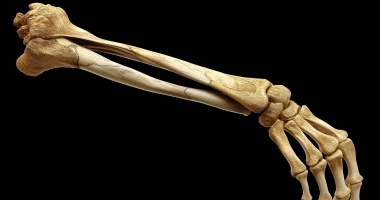Cavus foot
Cavus foot – what does it mean?
A cavus foot, or a high arch foot, is a condition where the longitudinal arch is more curved than usual.
About the disease
The foot is one of the main structural segments of the human musculoskeletal apparatus, providing its locomotor function. The foot is an integral morphofunctional object on which the human motor function depends.
With an increase in the height of the longitudinal arch, the foot becomes concave on the plantar side. It significantly hinders human movement and increases the load on other leg parts and the lumbar spine, even at rest.
The height of the longitudinal arch of the foot may be increased due to congenital or acquired structure features. Muscle innervation disorders, malunion fractures of the metatarsal bones, and genetic predisposition play a role in the etiology of cavus feet.
Conservative or surgical methods can carry out treatment of the cavus foot. The severity of the curvature determines the nature of the treatment program, the patient’s lifestyle, and the level of physical activity.
Types
The cavus foot, according to the nature of the etiologic factor, is of 2 types:
- congenital;
- acquired.
This deformity can be either unilateral or bilateral.
The cavus foot can be isolated or combined. In the latter case, increased flexion of the longitudinal arch may be combined with other foot anomalies. These may include pes equinus, valgus curvature of the first toe (so-called “ossicle”), calcaneal foot (emphasis is solely on the heel due to upward elevation of the forefoot), equino-varus and flat-valgus deformities.
Symptoms of a cavus foot
Symptoms of high-arch foot may include the following:
- rapid leg fatigue during physical activity, running, jumping, and prolonged walking;
- gait disturbance;
- painful and discomforting sensations in the sole area;
- discomfort in the ankle area;
- difficulty in choosing shoes and insoles;
- impaired functional activity of the lower limb;
- appearance of corns and calluses due to improper distribution of load on the plantar surface of the skin;
- decreased muscle tone of the lower extremities;
- the low strength of reflexes elicited from muscle tendons.
Causes of cavus feet
The causes of cavus feet are divided into two categories – congenital and acquired. One of the factors of abnormal structure is traumatic damage to the metatarsal bones involved in the formation of the longitudinal arch. Injuries sustained in childhood are hazardous, as the vaults of the foot are actively developing.
Cases of inheritance of cavus feet from immediate family members have been described. It is believed to be due to dysfunction of the muscular compartment of the foot. Thus, some muscles are hypertonic, while others, on the contrary, are excessively relaxed, which allows the foot to curve.
A category of predisposing factors that increase the likelihood of developing a cavus foot has now been identified. These include:
- neuromuscular diseases, including poliomyelitis, accompanied by damage to motor neurons;
- aggravated heredity;
- inflammatory lesion of the brain or spinal cord (those parts responsible for innervation of the muscles of the foot);
- neural tissue neoplasms;
- Improper consolidation of metatarsal fractures.
At the same time, modern medicine is actively studying the causes of cavus foot, since the exact mechanisms that lead to this deformity have yet to be established.
Diagnosis of a cavus foot
There are many methods for diagnosing the condition of the foot’s arch (clinical, graphic, radiographic, etc.). Examination of a patient with a suspected cavus foot begins with an objective examination of the foot. The doctor determines the arches’ shape and expression and performs palpation to detect painfulness.
The next step in the diagnosis is to perform a plantography (taking a footprint to identify the points of support). The plantogram allows you to confirm the diagnosis of a high-arch
foot. After that, the examination aims to identify possible causes of the pathological condition, primarily tumor and inflammatory lesions of the spinal cord and brain.
The following modalities may be included in the diagnostic program of patients with cavus feet:
- X-ray scan of the foot – helps to determine the position and shape of the metatarsal bones involved in the formation of the longitudinal arch;
- tomography (computer or magnetic resonance) – allows you to get layer-by-layer scans of the area under study and is highly informative.
Unlike CT, MRI is not accompanied by radiation exposure, so it can be performed in children when it is necessary to detail the state of a particular anatomical region. In addition, MRI is most informative for evaluating soft tissue structures, which are not always clearly visible on radiographs. The program of cavus foot diagnostics is made individually for each patient, taking into account the peculiarities of the clinical case.
Cavus foot treatment
The severity of the deformity determines the nature of the treatment of the cavus foot. In mild degrees of curvature, complex conservative therapy is indicated, and in severe deformity, corrective surgery is decided.
Conservative treatment
Conservative methods to affect the longitudinal arch of the foot include the following interventions:
- the use of specially made orthopedic insoles, which help to support the arch of the foot and reduce the load on the feet;
- application of manual therapy methods to strengthen the muscle corset;
- doing physical therapy exercises.
Surgical treatment
Surgery for a cavus foot is indicated in case of a pronounced deformity that limits a person’s physical activity and is accompanied by a persistent pain syndrome. The pathogenetic features of the curvature of the longitudinal arch determine the nature of surgical intervention. In some cases, excision of the affected bony area is required; in other cases, additional strengthening of the tendon-ligamentous apparatus is performed. Depending on the severity of the pathologic curvature, surgery can be a one-stage or multistage operation with gradual correction of the disturbed anatomy.
Surgical intervention radically solves the problem of cavus feet and improves a person’s standard of living (increases physical endurance, gets rid of persistent pain syndrome, and expands the possibility of selecting model shoes).
All these treatment options are available in more than 760 hospitals worldwide (https://doctor.global/results/diseases/cavus-foot). For example, Foot deformity correction can be done in 29 clinics across Turkey for an approximate price of $3.0 K (https://doctor.global/results/asia/turkey/all-cities/all-specializations/procedures/foot-deformity-correction).
Prevention
Effective methods of prevention of cavus foot still need to be developed. However, a specific role in the prevention of this deformity is played:
- wearing quality comfortable shoes designed to fit the anatomical and functional characteristics of the foot;
- timely treatment of neuromuscular diseases;
- regular check-ups with a podiatrist if there is a history of congenital foot deformities.
Rehabilitation
After surgical treatment of the high-arch foot, comprehensive rehabilitation is performed, which may consist of the following:
- performing therapeutic physical therapy exercises that help restore the muscle tone of the foot;
- physiotherapy procedures that improve blood supply to the structures of the foot and normalize the tone of muscle bundles;
- taping, which helps to stabilize the functional state of joints;
- course of therapeutic massage, which works on the ligamentous-muscular compartment of the foot;
- manual action has a complex effect on the structures of the foot.




